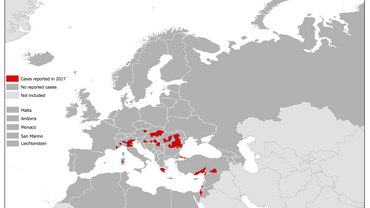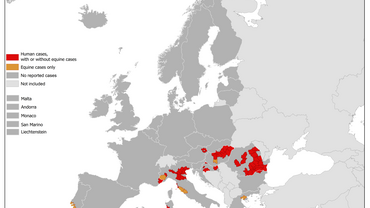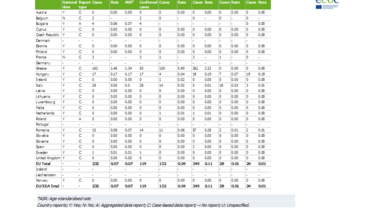Epidemiological update: West Nile virus transmission season in Europe, 2017
During the West Nile virus transmission season (June to November), ECDC publishes weekly epidemiological updates on human West Nile fever cases occurring in the European Union and the neighbouring countries. The updates are available via the Surveillance Atlas of Infectious Diseases. This year, for the first time, ECDC included equine West Nile fever cases in its epidemiological updates. During the 2017 transmission season, 204 human cases and 127 equine cases were reported in the European Union.
Human cases
The first cases in the European Union were infected in Greece late June and were reported at the end of July. The last case of the season was infected in Hungary and was reported mid-November. In the neighbouring countries, the first case was reported by Israel at the beginning of July. The last case of this transmission season was reported by Turkey at the end of November; the case had disease onset early September.
In the European Union, 204 human West Nile fever cases have been reported: Romania (66 cases), Italy (57), Greece (48), Hungary (21), Austria (5), Croatia (5), France (1) and Bulgaria (1). In the neighbouring countries, 84 cases were reported: Serbia (49), Israel (28) and Turkey (7). Twenty-six deaths due to West Nile fever have been reported, with a case fatality of nine percent: Romania (14 deaths), Greece (5), Hungary (2), Serbia (2), Italy (1), Croatia (1) and Turkey (1).
Romania reported a 1.4-fold decrease of human cases compared to the year before. Few affected areas in Romania had no previous reports of West Nile fever cases. Italy also reported cases in newly affected areas, e.g. in Livorno, along the western coast and in the north of the country, in Asti. After two consecutive years without any West Nile fever cases, in 2017, Greece reported again cases, including in areas where no cases were ever reported before. France reported one case in the Alpes-Maritimes, at the border with Italy, an area where no human West Nile fever cases were reported before. The last time France reported an autochthonous case was in 2015.
Serbia reported a similar number of human cases compared to the previous transmission season (n=41), but more compared to 2015 (n=28). Turkey reported several cases more than the previous year, including cases in areas without previous cases (i.e. in Istanbul and Icel). Considerably fewer West Nile fever cases were reported by Israel compared to the previous years, i.e. 125 and 84 cases in 2015 and 2016, respectively. No West Nile fever cases were documented in Russia this year. In 2016, Russia reported 135 cases.
Equine cases
This year, for the first time, ECDC included equine West Nile fever cases in its epidemiological updates. Equine cases are notified through the Animal Disease Notification System (ADNS) of the European Commission. Following a One Health approach, the maps including human and equine data aim to highlight areas, at the NUTS 3 level, where West Nile virus circulates in incidental hosts. During the 2017 transmission season 127 equine West Nile fever cases were reported by EU Member States through ADNS: 92 in Italy, 13 in Greece, 13 in Spain, three in Hungary, three in Portugal, two in Austria and one in France.
Related data
Related content
Disease page
West Nile virus infection
West Nile virus (WNV) infection is a mosquito-borne zoonosis. The virus is transmitted among birds via the bite of infected mosquitoes and incidentally humans and other mammals may become infected.







